|
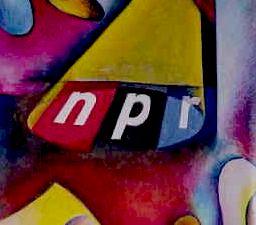
|
National Public
Broadcasting
NPR West
a new networked
West Coast presence
in
Culver City |
Written
by Mel Lambert
in January 2003
National Public Radio,
headquartered in Washington DC, should need little introduction. Established in
1970, NPR has grown during the past three decades to become a well-respected
multimedia outlet employing more than 700 reporters, producers, editors, on-line
and administrative staff. Today, NPR programming airs on 709 radio stations
operated by close to 300 member organizations. At a time when many news
companies are reducing operations, NPR News has expanded and today extends over
foreign and domestic bureaus.
NPR is renowned for journalistic excellence and standard-setting
news and entertainment programming. A nonprofit organization, NPR serves a
growing audience of nearly 27 million Americans each week. Cable, satellite and
short-wave services make NPR programming accessible anywhere in the world. But
an important part of the jigsaw was missing until earlier this year. NPR lacked
a substantial presence on the West Coast. "Given the importance of the West
Coast as a news source," offers Bud Aiello, NPR's Director of Engineering
Technology, "we realized that a full-service facility was required within the
Los Angeles area," to provide enhanced coverage of the western United States and
Pacific Rim.
After a search of available premises, a building was located in
Culver City, just south of Los Angeles, in a space that recently housed an
Internet video production and teleconferencing firm, complete with production
suites, support systems and technical build-out. The presence of an existing
technical infrastructure that included a high-power UPS, large-capacity AC,
generator transfer switch, a central facilities room and provision for satellite
dishes dramatically streamlined the conversion for radio production.
"Because this building already offered a number of
areas that we could modify for production and broadcasting," Aiello recalls, "we
could save a large mount of money, compared to taking an existing space and
converting it to our needs." The 25,000 square foot facility is the first
large-scale production center NPR has established outside of Washington, DC.
Eventually, NPR West will house a staff of 90, including NPR's Los Angeles News
bureau. It opened officially on November 2, 2002, just in time for
coast-to-coast coverage of the fall elections. Special series designed to
showcase the new location included one on California's Central Valley, and
another profiling individuals that exemplify the West. In addition, the facility
plays host to "The Tavis Smiley Show," and other new programs. Reported cost for
the NPR West project, including the $8 million purchase of land and a
two-building facility, was $13 million.
As NPR's second-largest facility, NPR West also
provides backup to the network, which produces, acquires and distributes some
120 hours a week of programming to stations around the U.S. "September 11th made
it apparent in a very urgent way that we need another facility that could keep
NPR going if something devastating happens in Washington," says Jay Kernis,
NPR's Senior VP for programming.
Flexible Networked Production and On-Air Studios
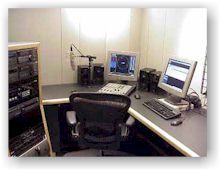 |
|
News Production 1 |
The new complex comprises five self-contained
production suites plus two on-air studios with companion control rooms. A
central Technical Center links all of the areas together via control and audio
data networks between the production/on-air areas and central equipment rooms,
and provides access to incoming and outgoing satellite and related circuits to
NPR's Washington DC production center and other locations as necessary.
Architects for the conversion project was studio bau:ton - architecture
principal Peter Grueneisen serving as lead architect/acoustical designer, and
Charles Irving as project manager - working closely with TGS Inc., a
Virginia-based system designer and integrator. (A 40-by-40-foot area with
associated control room is currently under consideration for use as a large
recording studio or video production stage.)
In terms of selecting production equipment for the
new facility, NPR went with what it knew. At both its Washington HQ and the New
York studios, networked hard-disk editors and asset-management systems from
Dalet Digital Media Systems had been specified. A Klotz VADIS II Audio Network
was also selected, with a variety of control surfaces tailored to the specific
needs of each production and on-air studio, to match hardware installed in DC.
"Our experience with these vendors has been very good, "Aiello says. NPR also
wanted to ensure operational and technical compatibility between Washington and
Los Angeles, so that staff can move freely between these locations and also to
allow remote control of critical functions.
As Aiello explains, Washington might need to take
in stories from Los Angeles without an engineer being on-call. "A reporter will
be able to enter [NPR West's] Production 4 or 5 and have an technician in DC
handle the interconnect from 3,000 miles way." High-speed DS3-level connections
to Washington will provide wide area networking of the Dalet playback and Klotz
routing systems, in addition to enabling real-time digital audio transfers. "A
total of nine MPEG Layer-2 [data-compression] codecs operating at 384 kbits
connect [NPR West] to Washington," Aiello explains. "Codecs one thru four are
normalled to the stereo outputs from the main on-air studios A, B and C [A is
currently under consideration] plus the Tech Center. The remaining five ports
are used for various mono/stereo feeds." At the Washington DC facility the
outputs from NPR West's Studios and Technical Center appear as dedicated inputs
on the Routing Switcher, for direct access by the facility's various production
areas and satellite distribution network.
The use of close to 60 Dalet workstations for
audio recording, playback and asset management, plus eight Klotz digital
consoles for level control and routing, dramatically streamlines the networking
process. Dalet playback ports are normalled digitally to Klotz inputs, while
outputs are routed to recorder inputs; various system topologies have been
developed to let radio journalists run the five Production Suites by themselves,
while conventional operators are used in the large-format studios. But for added
flexibility, microphone and playback sources in the Production Suite 4 adjoining
one of the main air studio can be routed to the latter's control room's console
surface; a glass window between the two rooms provides visual communications for
engineering staff and producers.
"We designed the five Production Suites so that
reporters and producers could handle everything from a central, self-contained
location," Aiello explains. "Suites #4 and #5 are slightly different since they
also house a Telos Zephyr system that can feed material directly to Washington,
for example, via a [bidirectional] ISDN network connection. In this way we can
also go live to the [NPR] network from any of these rooms, if necessary."
Assignable Digital Control Surfaces
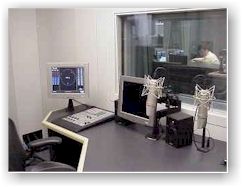 |
|
News Production 4 and Studio B |
NPR West's Klotz digital mixing engines comprise a
series of DCII Control Surfaces linked via high-speed Ethernet local area
networks connected to VADIS (Variable Audio Distribution Interface System)
processing cores and routers located in a number of technical areas throughout
the complex. According to Karl Schoning, Klotz' Director of Engineering, "the
DCII [controller] can be supplied with up to 56 moving faders; each individual
assignable channel strip contains a level fader, pan (with use-selectable
profiles), mute and optional EQ and/or dynamics." A/B source selection plus
eight programmable buttons are also provided per module, while real-time
EQ/dynamics displays are accessed via the system's LCD screens.
"NPR West's central mainframe houses the VADIS 880
DSP controller/router that handles assignment of the control surface's various
shaft encoders and programmable switches," Schoning adds. The system is
configured with a number of mic pre-amps, analog inputs, AES-EBU and S/P-DIF
digital inputs, MADI, ADAT optical, RS232/422 serial control and other ports.
"By creating a two-layered system in VADIS we have
separated audio from control," stresses Klotz Project Leader Jonathan Burtner,
allowing the routing of logic/machine control information, audio signals, serial
information, program-associated data information and digital sync while
eliminating approximately 90% of traditional inter-room cabling. "And our TDM
[time division multiplex technology] has allowed us to design a system with
scaleable DSP that results in an unlimited bus structure."
Instead of traditional crosspoint switching, the
VADIS AudioMedia router's TDM-based switching allows the system to route 256
channels of audio per VADIS frame; an unlimited number of frames may be
interconnected simultaneously via a high-speed fiber optic network. "Our
patented software allows VADIS frames to 'speak' [to an another] via the TDM
bus," Burtner explains, "allowing the addition of as many VADIS frames as needed
by the client." While audio is distributed from one VADIS frame to another via
fiber optic cables, logic/machine control information travels over a closed
Ethernet-based LAN between individual consoles so that operators can create a
customized logic-control topology. VADIS frames and controller engines can be
located remotely or in the same room as the DCII surface, or both, depending on
user's requirements. VADIS' unique combination of TDM and fiber optics means
that an unlimited number of virtual control surfaces can be connected to the
system.
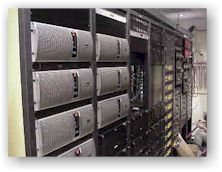 |
|
Klotz VARDIS router racks |
The universal VADIS 880 mainframe accepts a
variety of audio, data and DSP modules without limitation to inputs or outputs.
All VADIS frames can act as a master digital audio sync, but can also slave to
external house-clock references, including an nVision NS-5500 Universal Sync
Generator that was supplied to NPR West. The frame comes standard with a dual
fail-safe power supply and dual redundant digital audio sync modules.
NPR West's five Production Suites each feature
four-fader VADIS DCII console surfaces, while the two On-Air Studios and
Technical Center were supplied short-loaded with 20-fader surfaces, and hence
room for expansion. Any source connected to any console surface can appear on
any fader; entire console setups of sources, mix-minus, dynamics, EQ, bus
assignments, and so on can be recalled at the push of a button. Typical mixer
layouts provide source selection per fader, or several fader channels connected
to the external router. TFT screens in each room display system settings plus
graphics for EQ/dynamics parameters. Each DCII can address four stereo output
buses - PGM, AUD, UTL and Mix-Minus - plus various mix-minus DSP options, each
with an individual talkback features and stereo/mono configuration.
"Because of the VADIS system's distributed
processing and closed LAN topology," says Greg Mensching, former Klotz Digital
Sales Engineer and system/technical designer for the NPR project, "there are no
slaves and masters as such. Any console surface, in theory, can control any
processing element anywhere in the building or, with access to the LA-to-DC wide
area network, anywhere in the NPR system. Integrating consoles, audio routers,
logic-follow capabilities and distribution of digital audio sync can be a
formidable proposition; VADIS networking is designed to dramatically streamline
that process for NPR West."
Networked Digital Audio Workstations and Editing Systems
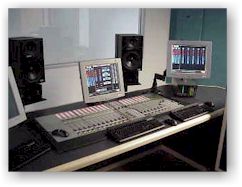 |
|
Technical Center/Master Control |
As with NPR's New York and Washington facilities,
NPR West features Dalet Digital Media Systems editing workstations, along with
several high-capacity digital audio servers. The Dalet 5.1 Advanced Pro System
comprises an array of 55 workstations connected via a 100-megabit Ethernet LAN
to five servers that communicate with central hard drives via a high-speed
fiber-channel topology. (NPR has also installed 280 Dalet workstations
throughout its main Washington DC facilities.)
According to Ken Tankel, Dalet's North-East Sales
Manager, "The system provides real-time sharing of all digitized media files
that NPR [journalists and producers] generate for their programs. For high
demand systems, requiring a terabyte of more of storage, we specify IBM Series
Fast-T 500 storage [arrays that] are configured in RAID-5 topology to ensure
instant recover from any hardware failure," linked Windows-based PCs for desktop
editing and programming. A dual-loop fiber channel connection to each or the
arrayed hard drives also provides additional network redundancy. A total of 5
Terabyte of digitized audio and metadata can be stored in the NPR West facility.
"This is not the largest Dalet server array [being used by] a radio customer,"
Tankel concedes. "XM Satellite Radio, for example, which provides 100 channels
of [US satellite delivery programming], features 28 Terabytes of data - some 1.8
million songs - shared by a total of 350 workstations."
Dalet's 5.1 Advanced Pro System uses a
client/server architecture to provides real-time audio playback at any of the
networked workstations, reading/writing audio files directly to NT/2000-based
servers arrayed on a TCP/IP-driven LAN. Dalet's media asset management system
provides an integrated digital audio environment for recording, editing, and
storing audio, plus log creation and automated/live playback. All of NPR West's
production studios, voice-over rooms, news preparation areas, producer areas and
central control rooms are networked through the media asset management system.
Since industry-standard TCP/IP and FTP protocols are used for most data
transport within the network, and to/from external sources, the architecture
does not rely on a proprietary, potentially unreliable operating system.
Sybase SQL Professional ASE or Microsoft SQL
serves as the database for digital audio files and asset management; a single
database references audio, text, multimedia files and other program-associated
data associated with these files. The Dalet system can edit and play out linear
PCM, MPEG-Layer 2 and MPEG-Layer 3 data-compressed files, in stereo or mono,
interchangeably.
"Our editing software handles eight stereo tracks
simultaneously," Tankel considers, "and eliminates multiple transcodings. The
Dalet editing software generates EDLs that are executed when a 'project' is
saved. The EDL is executed on the MPEG files in dedicated DSP or using the
workstation's CPU." Transcodings only occur if the finished format is different
from any of the formats in the project.
Various software components handle specific
functions within the Dalet server and workstation network. For example, manual
recording, automated recording, two-, four- and eight-track editing, manual and
automated play out are all modules that can appear on the desktop. A flexible
user rights management system allows user access to specific tools and desktop
environment to tailored specific needs and skills.
Studio Design and Modified Acoustics
According to studio bau:ton's Peter Grueneisen, "[NPR's] architectural plan
calls for serious acoustical improvements, which were accomplished with floating
floors and new, heavy room shells in the two larger studios and with isolation
cuts in the slab around the smaller rooms. Although the layout of the building
did not need substantial changes, the rooms essentially had to be rebuilt." To
provide enhanced sound isolation within the three edit suites and pair of
production areas, modular, prefabricated broadcast booths from Wenger
Corporation were assembled inside the existing areas. The self-sealing Wenger
rooms can be installed in a studio without fasteners, caulking or permanent
attachments to a building structure.
"For the larger control rooms and on-air studios,"
offers studio bau:ton's Project Manager, Charles Irving, "we decided to raise
and float the concrete slabs. For acoustical room treatments we used three
products that were selected for their economy not only as material, but also for
ease of installation. On the walls we used a combination of Bonded Acoustical
Fabric Pad (BAFP), which is a fiberglass-free material produced from recycled
cotton rag, and Porous Expanded Polypropylene panels (PEPP). These panels were
either bonded directly to the gypsum board surfaces or, where we needed to cover
acoustic wall and ceiling cavities, we employed a system of wire-mesh backing or
exposed wood battens. On the ceilings we specified a combination of PEPP and
Sonex, utilizing using similar attachment methods." Acoustical Surfaces, Inc.
supplied the BAFP and PEPP products plus Sonex. Systems integrator TGS Inc.
supplied the various studio desks and control room furniture.
"NPR West is the one of the most significant
developments in NPR's capacity to provide programming services to stations and
listeners in the past two decades," says Kevin Klose, NPR's president and CEO.
"Years of thoughtful analysis, months of careful site selection and detailed
facility planning have gone into NPR West. This means a huge expansion in our
capacity to bring timely, comprehensive news of the West to our national
newsmagazines, newscasts and cultural programming. The unique sounds and
energies of this storied region and its people will be heard in lively new ways
from NPR West."


©2023 Media&Marketing. All Rights Reserved. Last revised:
02.20.23
|




